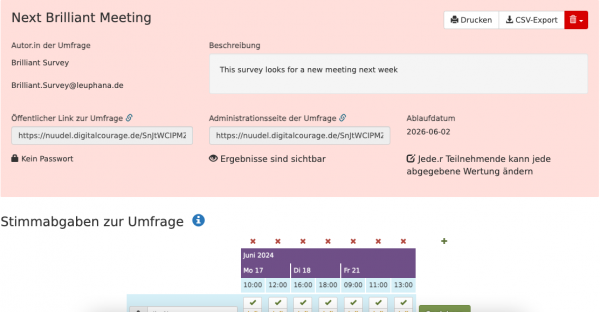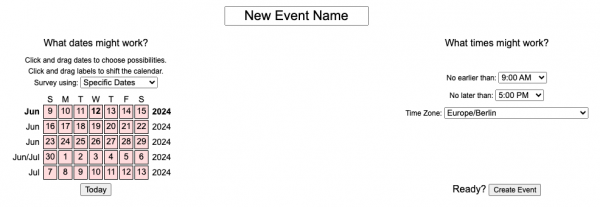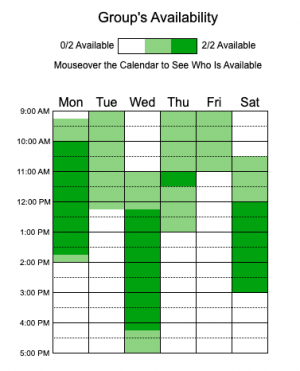How to Doodle/Nuudle (Date Survey Tools)
| Type | Team Size | ||||||
|---|---|---|---|---|---|---|---|
| Me, Myself and I | Group Collaboration | The Academic System | Software | 1 | 2-10 | 11-30 | 30+ |
In short: This entry gives an overview of possible online appointment survey tools for any kind of group work, as well as Do’s and Don’ts when setting them up.
Contents
Why & When
Finding regular or specific meeting dates with your peer working group, initiative or academic committees, online surveys are often used. They come in multiple shapes and sizes - meaning in various user interfaces, visualizations and data protection levels. Most of them are created by one person and can be sent around via e.g. email using a link that leads to the survey.
Examples for Date Survey Tools
In the following, three prominent examples are presented, each with their strengths and weaknesses.
Doodle
Doodle is a commercial tool that also contains adverts. In order to use this tool, you first need to create an account for free using your email address and a password. After that, you can choose between four possible ways to create an appointment/date survey:
1) Group Survey
This is the most common and most prominent way. You name the survey and optionally describe the occasion and a meeting location. Then, you clarify how long the appointment/meeting is supposed to be. Next, you choose the specific dates within one week, several weeks or even a month, as well as the specific time slots. In the free version, you can select up to 20 dates. Doodle then offers multiple setting options: setting a deadline to fill out your survey, limiting possible answers, sending automatic reminders, hiding the list of participants etc. Finally, you create and “publish” the finished survey, using different means to share the link.
2) 1:1
This option has the same steps and settings, it is however directed not to a group of people but just for one other person who can, after clicking on the link that you shared, select an appointment date from a list that you offer (set up via this survey tool).
3) Booking
If you want to use this option, Doodle needs to be connected with your calendar so you have to give permission and set it up. You can then define times in which you are available and let people make appointments with you via this booking interface.
4) Event Planning
This option is still in its beta phase (a beta product), so there can still be changes to the interface and functions over time. Again, this option follows similar steps, including naming the event, describing it etc. This time, you add meetings (events) as closed options. You give information on the date, starting time, duration and seats/number of participants. In the free version, you can add up to 99 events in one survey to which the link receiver can sign up to.
Strengths: Doodle is very common and mostly user friendly. It is practical and fulfills the aspects that you would wish for when setting up a meeting survey, either for one or many participants. Especially, the settings with automated reminders or deadlines can come in handy when dealing with participants that are e.g. quite busy or tend to forget survey links.
Weaknesses: The tool has been criticized as to how they process and store data. This may seem less interesting in the case of group surveys, but is quite concerning with the optional linking of a personal calendar to the online tool. The location and all meeting specifics can also be rather critical/sensitive and most probably not something that you want to have tracked by a software.
Nuudle
This tool is a data-secure alternative to Doodle. This “not-tracking” appointment tool is offered for free by a non-profit organization (Digitalcourage e.V.) and has two options to create a survey.
1) Finding a date for a meeting
First, the classical date survey starts with filling out your name, an email address and a title, as well as the optional occasion description. Similar to Doodle, you can change settings and add e.g. a password to further secure the survey from external access. Secondly, you add a list of date suggestions. Thirdly, you get a summary of your suggested appointments and the info that the survey is automatically deleted 720 days after the last suggested date and the option to move this date of deleting forward. Finally, you can publish and share the survey. You will then get 2 emails, one with the link to the survey for participants and one with the link to the administration page of your survey.
2) Classical Survey
The other survey option is more of a classical survey that is not focused on dates or appointments but rather on choosing between different options e.g. which movie to watch on your next movie night with friends.
Strengths: Nuudle has more data protection without lacking any user friendliness or functionality. It is low-threshold, well-guided through and has an intuitive user interface for the participants.
Weaknesses: Nuudle is less known or common to many date survey users, so there might be hesitation to get used to a new tool, even though is it quite similar to Doodle and people receiving a Nuudle link instead of a Doodle link will not be that confused when filling out the survey besides the name of the tool:) So give it a try in your next quest to find a meeting slot for your seminar group work.
Leuphana - specific: At Leuphana, they sometimes also use a product for data protected surveys that looks similar like the Nuudle interface, which is called “DFN terminplaner”. This tool is carried by another association, the Verein zur Förderung eines Deutschen Forschungsnetzes e. V. and fulfills most of the functions mentioned above. It is often used for official surveys to find meeting dates for academic commissions with many external members due to it being in line with the university’s data policy.
When2Meet
This tool follows a slightly different logic and interface which may be quite helpful, so consider giving it a try. It is easy to use and does not require any registration via email or creating an account. The interface looks as follows: Firstly, you give your survey a name, most ideally the name of the respective event.
Secondly you choose between using specific dates from a calendar OR using days of the week that can be applicable to any following weeks. This is beneficial when you are looking for a new regularly recurring meeting slot for e.g. your student initiative.
Thirdly, you specify that your event starts no earlier than a given time and can go no later than another time. For instance, you select three dates and the survey than only gives the option to participants to indicate whether or not they are free in a time frame of 8 am until 4 pm.
After creating the event, you have different options to share the survey, easiest is via the link.
As a participant (that you yourself most probably are as well), you can give a nickname and “sign in” with or without a password, so that others can later hover about the availability list and see which person is free at which times.
The interface looks somewhat like this, for a survey on “days of the week” availability:
On the left hand side, there is an overview of your personal availability to fill out. You can click a time and push the mouse down, just until you are not available anymore.
Simultaneously, the rights hand side will be updated (with your answers). If you are the first one to fill it out, there will be only your availabilities. The more people fill out the survey, the more layers there will be. Light green indicates that few group members are available, white areas are times when no one is available, darker greens indicate many available members at that time/date. The legend above gives orientation for this color scheme. When hovering over the timeslots you can see, who is (un-)available at that time.
An example of what a survey filled out by two people can look like this:
Strengths: When2Meet follows a slightly different logic than the other presented and common tools. This can be helpful and refreshing, either for the search of new regular meetings or specific singular meetings. The result also has the benefit of being quite intuitive (darker green spots are times when most members are available) and is shows (nick)names of participants so that there can be efficient follow-up messages or new surveys considering individual’s availabilities.
Weaknesses: The different logic and interface might be confusing at the beginning and there may be people that are against using a new tool. Consider explaining it first or give a quick run-through, or even easier, just share this article with them.:)
A tool that is quite similar to When2Meet, but looks even more fun is called Crab Fit. You can check it out here: https://crab.fit/. Since it functions like the tools above, you should be fully equipped now and ready to try it yourself.
Setting up a great Date Survey
A good date survey…
- has a limited amount of options to choose from, 20 are too many (meaning time slots, days, weeks)
- indicates clearly what it is for
- is followed-up upon (soon after sharing the survey, there is someone sharing the results and updating on next meeting dates)
- ideally uses a data secure/protecting survey tool
- has an easy, intuitive user interface that gives a simple overview
In other words, mistakes to avoid:
- Do not overload the survey with possible days/options. No one will be motivated to fill it out and take the time and effort.
- If the survey tries to find a new regular meeting date (time slot for several weeks): try to choose diverse time slot options, e.g. starting early in the day until later afternoons.
- Depending on whether or not you have a code of conduct: try not to propose time slots that start later than agreed upon (e.g. parents would like to be home at some point, no meeting start after 6 pm).
- Always follow-up on it! Never sending the result or never informing the participants about possible struggles is very annoying. For example, in case no date is found that fits for all members or an important participant is not available in any proposed time slot, you might need to set up a new survey and inform everyone. Remember to update on the chosen meeting date!
Links to the tools
- Doodle: https://doodle.com/welcome
- DFN terminplaner: https://terminplaner6.dfn.de/de/node/add/meetingpoll
- When2Meet: https://www.when2meet.com/
- Crab Fit: https://crab.fit/
- And if you drown in unanswered surveys and want to motivate yourself or others: https://open.spotify.com/intl-de/track/6hEy2N5HdOmBodT66vYosI?si=24a6f9b89ab444ef
The author of this entry is Linda von Heydebreck.




